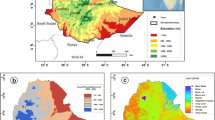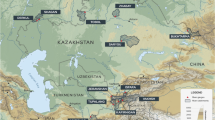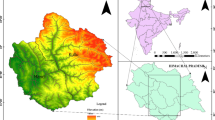Abstract
Taking the Lhasa River Basin above Lhasa hydrological station in Tibetan Plateau as a study area, the characteristics of the annual and monthly mean runoff during 1956–2003 were analyzed, based on the hydro-data of the two hydrological stations (Lhasa and Tanggya) and the meteorological data of the three meteorological stations (Damxung, Lhasa and Tanggya). The trends and the change points of runoff and climate from 1956 to 2003 were detected using the nonparametric Mann-Kendall test and Pettitt-Mann-Whitney change-point statistics. The correlations between runoff and climate change were analyzed using multiple linear regression. The major results could be summarized as follows: (1) The annual mean runoff during the last 50 years is characterized by a great fluctuation and a positive trend with two change points (around 1970 and the early 1980s), after which the runoff tended to in-crease and was increasing intensively in the last 20 years. Besides, the monthly mean runoff with a positive trend is centralized in winter half-year (November to April) and some other months (May, July and September). (2) The trends of the climate change in the study area are generally consistent with the trend of the runoff, but the leading climate factors which aroused the runoff variation are distinct. Precipitation is the dominant factor influencing the annual and monthly mean runoff in summer half year, while temperature is the primary factor in winter season.
Similar content being viewed by others
References
Bosch J M, Hewlett J D, 1982. A review of catchment experiments to determine the effect of vegetation changes on water yield and evaportranspiration. Journal of Hydrology, 55: 3–23
Calder, 2000. Land Use Impacts on Water Resources. Land-Water Linkages in Rural Watersheds Electronic Workshop, 18 Sept.–27 Oct. FAO.
Cao Jianting, Qin Dahe, Kang Ersi et al., 2005. The runoff variations of the primary rivers in the Tibetan Plateau. Chinese Science Bulletin, 50(21): 2403–2408. (in Chinese)
Chen Junfeng, Li Xiubin, Zhang Ming, 2004. Model Simulation of the impact of climate fluctuation and land-cover changes on annual runoff in the Suomo Basin. Science in China (Series D), 34(7): 668–674. (in Chinese)
Chu Duo, Zhang Yili, Zheng Du, 2005. Land-use change scenario in Lhasa district using Markov chain model. Geographical Research, 24(6): 869–877. (in Chinese)
Comprehensive Scientific Expedition to the Qinghai-Xizang Plateau, Chinese Academy of Sciences, 1984. Climates of Xizang (Tibet). Beijing: Science Press. (in Chinese)
Comprehensive Scientific Expedition to the Qinghai-Xizang Plateau, Chinese Academy of Sciences, 1984. Rivers and Lakes of Xizang. Beijing: Science Press. (in Chinese)
Deng Huiping, Li Xiubin, Zhang Ming et al., 2001. A study of changes in hydrology resulting from climate and land cover changes in the Suomo Basin. Scientia Geographica Sinica, 21(6): 493–497. (in Chinese)
Ding Yongjian, Ye Baisheng, Liu Shiyin, 2000. Impact of climate change on the alpine streamflow during the past 40a in the middle of the Qilian Mountains, northwestern China. Journal of Glaciology and Geocryology, 22(3): 193–199. (in Chinese)
Donald H Burn, Mohamed A Hag Elnur, 2002. Detection of hydrologic trends and variability. Journal of Hydrology, 55: 107–122.
Dong Guangrong, Dong Yuxiang, Li Sen et al., 1996. Study on Plan of Desertification Treatment in the Mid-stream Region of Yarlung Zangbo River, Tibet. Beijing: China Environmental Science Press. (in Chinese)
Du Jun, 2001. Recent change of air temperature for 40 years in Qinghai-Xizang Plateau. Acta Geographica Sinica, 56(6): 682–690. (in Chinese)
Gong Tongliang, Liu Changming, Liu Jingshi. Hydrological response of Lhasa River to climate change and permafrost degradation in Xizang. Acta Geographica Sinica, 2006, 61(5): 519–526. (in Chinese)
He Yuanqing, Zhang Zhonglin, Yao Tandong et al., 2003. Modern changes of the climate and glaciers in China’s monsoonal temperate-glacier region. Acta Geographica Sinica, 58(4): 550–558. (in Chinese)
Hirsch R M, Slack J R, Smith R A, 1982. Techniques of trend analysis for monthly water quality data. Water Re-sources Research, 18: 107–121.
Hu Shulin, Wang Jianlin, 1999. The development and utilization of the water resources in the Yarlung Zangbo-Nyangqu-Lhasa River region. Territory and Natural Resources Study, 2: 16–18. (in Chinese)
Kendall M G, 1975. Rank Correlation Measures. London: Charles Griffin.
Klein J A, Harte J, Zhao X Q, 2004. Experimental warming causes large and rapid species loss, dampened by simulated grazing, on the Tibetan Plateau. Ecology Letters, 7(12): 1170–1179.
Lai Zuming, 1996. Impact of climate variation on t he runoff of large rivers in the Tibetan Plateau. Journal of Glaciology and Geocryology, 18(suppl.): 314–320. (in Chinese)
Lin Zhenyao, Zhao Xinyi, 1996. Spatial characters of temperature and precipitation in the Tibetan Plateau. Science in China (Series D), 26(4): 354–358. (in Chinese)
Liu Tianchou, 1999. Hydrological characteristics of Yarlungzangbo River. Acta Geographica Sinica, 54(suppl.): 157–164. (in Chinese)
Mann H B, 1945. Non-parametric tests against trend. Econometric, 13: 245–259.
Mi Desheng, Xie Zichu, Luo Xiangrui et al., 2002. Glacier Inventory of China XI, the Ganga Drainage Basin and Indus Drainage Basin. Xi’an: Xi’an Cartographic Publishing House. (in Chinese)
Ning Aifeng, Yin Guan, Liu Tianchou, 2000. Characteristics of isotope distribution of atmospheric precipitation in the Lhasa River area. Journal of Mineralogy and Petrology, 20(3): 95–99. (in Chinese)
Omar I Abdul Aziz, Donald H Burn, 2006. Trends and variability in the hydrological regime of the Mackenzie River Basin. Journal of Hydrology, 319: 282–294.
Perreault L, Haché M, Slivitzky M et al., 1999. Detection of changes in precipitation and runoff over eastern Canada and U.S. using a Bayesian approach. Stochastic Environmental Research and Risk Assessment (SERRA), 13(3): 201–216.
Pettitt A N, 1979. A non-parametric approach to the change-point problem. Applied Statistics, 28(2): 126–135.
Pettitt A N, 1980a. A simple cumulative sum type statistic for the change-point problem with zero-one observations. Biometrika, 67: 79–84.
Pettitt A N, 1980b. Some results on estimating a change-point using nonparametric type statistics. Journal of Statistical Computation and Simulation, 11: 261–272.
Rowan Fealy, John Sweeney, 2005. Detection of a possible change point in atmospheric variability in the North Atlantic and its effect on Scandinavian glacier mass balance. International Journal of Climatology, 25: 1819–1833.
Shi Yafeng, Liu Shiyin, 2000. Estimation of the response of Chinese glacier to the global warming in the 21st century. Chinese Science Bulletin, 45(4): 434–438. (in Chinese)
Sirois Allan, 1998. A brief and biased overview of time series analysis on how to find that evasive trend. In WMO Report No.133: WMO/EMEP Workshop on Advanced Statistical Methods and Their Application to Air Quality Datasets 1998.
Tang Maocang, Bai Chongyuan, Fengsong et al., 1998. Climate abrupt change in the Qinghai-Xizang Plateau in recent century and its relation to astronomical factors. Plateau Meteorology, 17(3): 250–257. (in Chinese)
Wang Genxu, Shen Yongping, Cheng Guodong, 2000. Eco-environmental change and causal analysis in sources regions of the Yellow River. Journal of Glaciology and Geocryology, 22(3): 200–211. (in Chinese)
Wang Jianlin, 1994. The analysis of the hydrological characteristics of the Yarlung Zangbo River and its anabranches. Bulletin of Soil and Water Conservation, 14(2): 54–58. (in Chinese)
Wang Shaowu, Zhu Jinhong, Cai Jingning, 2004. Interdecadal variability of temperature and precipitation in China since 1880. Advances in Atmospheric Sciences, 21(3): 307–313.
Wu Shaohong, Yin Yunhe, Zheng Du et al., 2005. Climate changes in the Tibetan Plateau during the last three decades. Acta Geographica Sinica, 60(1): 3–11. (in Chinese)
Wu Tao, Yuan Peng, Dai Lu et al., 2005. Research on the stream flow forecast methods of Tibet Lhasa River. Water Conservancy Science and Technology and Economy, 11(2): 77–79. (in Chinese)
Yan Zhongwei, Ji Jinjun, Ye Duzheng, 1990. The 1960s Northern Hemispheric summer climatic jump-precipitation and temperature variations. Science in China (Series B), 33(1): 97–103. (in Chinese)
Yang Xuchao, Zhang Yili, Zhang Wei et al., 2006. Climate change in Mt. Qomolangma region in China during the last 34 years. Acta Geographica Sinica, 61(7): 687–696. (in Chinese)
Yao Tandong, Zhu Liping, 2006. The response of environmental changes on Tibetan Plateau to global changes and adaptation strategy. Advance in Earth Sciences, 21(5): 459–464. (in Chinese)
Ye Duzheng, Yan Zhongwei, 1993. Climatic Jumps in the History: Climatic Variability. Beijing: China Meteoro-logical Press, 3–14.
Zhang Yili, Li Xiubin, Fu Xiaofeng et al., 2000. Urban land use change in Lhasa. Acta Geographica Sinica, 55(4): 395–406. (in Chinese)
Zheng Du, Lin Zhenyao, Zhang Xueqin, 2002. Progress in studies of Tibetan Plateau and global environmental change. Earth Science Frontiers, 9(1): 95–102. (in Chinese)
Zheng Du, Yao Tandong, 2004. Uplifting of Tibetan Plateau with Its Environmental Effects. Beijing: Science Press. (in Chinese)
Author information
Authors and Affiliations
Corresponding author
Additional information
Foundation: National Basic Research Program of China, No.2005CB422006; National Natural Science Foundation of China, No.90202012; No.40561002
Author: Lin Xuedong (1982–), MS, specialized in the LUCC and the hydrological effects.
Rights and permissions
About this article
Cite this article
Lin, X., Zhang, Y., Yao, Z. et al. The trend on runoff variations in the Lhasa River Basin. J. Geogr. Sci. 18, 95–106 (2008). https://doi.org/10.1007/s11442-008-0095-4
Received:
Accepted:
Published:
Issue Date:
DOI: https://doi.org/10.1007/s11442-008-0095-4




